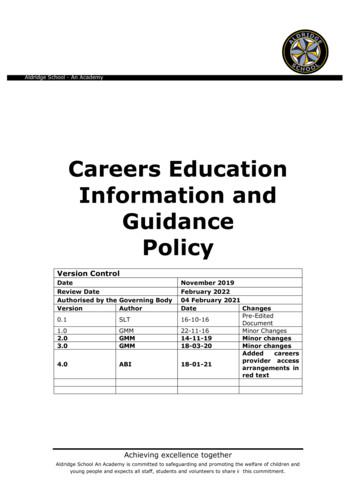Careers In Construction: Building Opportunity - Bureau Of Labor Statistics
Careers in construction: BuildingopportunityElka Torpey August 2018Perhaps you enjoy working with your hands on projects that will be around for years to come. Or maybe you’relooking for a job that pays well and has a promising future. These are among the many reasons to consider acareer in construction.In June 2018, there were 263,000 job openings in the construction industry, according to preliminary estimatesfrom the U.S. Bureau of Labor Statistics (BLS). Through 2026, BLS projects faster-than-average employmentgrowth in the industry. What’s more, its median annual wage of 45,820 in 2017 surpassed the 37,690 medianwage for all industries.And although some occupations in the construction industry typically require a college degree, you can enter manyothers with a high school diploma or less education. Read on to learn about construction careers.1
U.S. BUREAU OF LABOR STATISTICSCareer OutlookRebounding employmentPreliminary BLS data show that there were 7.2 million construction jobs in July 2018. That marks the highestemployment level for the construction industry in a decade.Leading into and through the Great Recession, the industry experienced declines in employment. In recent years,however, employment has trended upward. (See chart 1.)BLS expects continued expansion of employment in the construction industry, with more than 7.5 million jobsprojected by 2026 as population growth spurs demand for new buildings and infrastructure.Occupations by subsectorThe construction industry comprises three subsectors: specialty trade contractors, construction of buildings, andheavy and civil engineering construction. Employment in all of these subsectors is projected to grow over the2016–26 decade, with more than half (485,600) of the new jobs overall expected in specialty trade contractors.Construction of buildings and heavy and civil engineering construction are projected to add 170,300 and 208,800jobs, respectively. Wages vary by occupation.2
U.S. BUREAU OF LABOR STATISTICSCareer OutlookThe tables in this section show selected occupations in each of the construction subsectors. There is overlapamong the occupations in each, so inclusion in one table doesn’t mean exclusion from another. For example,construction laborers work in all three subsectors.Specialty trade contractorsSpecialty trade contractors is the largest construction subsector, with employment projected to reach nearly 4.8million by 2026. Workers in this subsector usually focus on a particular activity, such as plumbing or roofing. (Seetable 1.)3
U.S. BUREAU OF LABOR STATISTICSCareer Outlook4
U.S. BUREAU OF LABOR STATISTICSCareer OutlookBLS projects rapid employment growth in specialty trade contractors for all of the occupations in the table. Withnearly 20-percent increases in this subsector, employment of heating, air conditioning, and refrigeration mechanicsand installers and helpers of pipelayers, plumbers, pipefitters, and steamfitters is projected to grow the fastest ofthese occupations. Electricians had the highest median annual wage, 52,170, in this subsector in 2017.Construction of buildingsEmployment in construction of buildings is projected to be about 1.7 million in 2026. This subsector includesgeneral contractors and other establishments that have primary responsibility for an entire building or remodelingproject. (See table 2.)5
U.S. BUREAU OF LABOR STATISTICSCareer Outlook6
U.S. BUREAU OF LABOR STATISTICSCareer OutlookAll but one of the occupations in table 2 (carpenters) are projected to have faster-than-average employmentgrowth in this subsector from 2016 to 2026. Employment in each of the other occupations in the table is projectedto grow by about 14 percent in this subsector. Construction managers had the highest pay of the occupations intable 2, with a median annual wage of 90,380 in construction of buildings in 2017.Heavy and civil engineering constructionHeavy and civil engineering construction focuses on highway, utility, and other infrastructure projects; employmentin this subsector is projected to be almost 1.2 million in 2026. Table 3 shows some of the occupations involved inthis work.7
U.S. BUREAU OF LABOR STATISTICSCareer Outlook8
U.S. BUREAU OF LABOR STATISTICSCareer OutlookBLS projects much-faster-than-average employment growth in heavy and civil engineering construction over the2016 26 decade for the occupations shown in table 3. Employment growth of electrical power-line installers andrepairers is expected to be the fastest, with a projected increase of nearly 39 percent in heavy and civilengineering construction. These installers and repairers also had the highest median annual wage, 60,320, ofoccupations shown in the table.Paving the way to a careerMost construction careers require specific skills and aptitudes, such as dexterity, physical stamina, and problemsolving ability. Construction workers learn many of the skills they need on the job. In fact, all but one of theoccupations shown in the tables typically require on-the-job training for workers to become competent.Apprenticeships are common in some occupations, such as sheet metal workers and plumbers. In otheroccupations, new workers may get informal on-the-job training, including instruction from those who haveexperience.Whether you have little formal education or you aspire to earn a college degree, you can choose from a number ofoccupations in construction. For example, occupations such as roofers and carpenters’ helpers typically require noformal educational credential at the entry level. And you can typically enter more than half of the occupationsshown in the tables with a high school diploma or its equivalent, such as a GED.You typically need a certificate or other postsecondary nondegree award to enter the occupations of heavy andtractor trailer truck drivers and heating, air conditioning, and refrigeration mechanics and installers. The three9
U.S. BUREAU OF LABOR STATISTICSCareer Outlookhighest paying occupations in the tables—construction managers, cost estimators, and civil engineers—typicallyrequire a bachelor’s degree for entry.For more informationFind detailed information about entry requirements, job outlook, and more for these occupations—and hundreds ofothers—in the Occupational Outlook Handbook. Data on the physical, mental, and cognitive demands;environmental conditions; and vocational-preparation requirements in these occupations are available from theOccupational Requirements Survey.Elka Torpey is an economist in the Office of Occupational Statistics and Employment Projections, BLS. She can be reached attorpey.elka@bls.gov.SUGGESTED CITATION:Elka Torpey, "Careers in construction: Building opportunity," Career Outlook, U.S. Bureau of Labor Statistics, August 2018.RELATED CONTENTApprenticeships: Occupations and outlookJobs for people who love being outdoorsProjections of industry employmentProjected new jobs by major industry sectorSmall business optionsInterview with a.PlumberInterview with a.WoodworkerRELATED SUBJECTSApprenticeshipOn-the-job trainingCareer planningOutdoorsConstructionProjectionsGEDHigh schoolSeasonal jobs10Occupations
U.S. BUREAU OF LABOR STATISTICS Career Outlook . 10. highest paying occupations in the tables—construction managers, cost estimators, and civil engineers—typically require a bachelor's degree for entry. For more information. Find detailed information about entry requirements, job outlook, and more for these occupations—and hundreds of
Careers & Enterprise Company: Guide for new Careers Leaders in schools. Essential information, helpful resources and practical tools to help newly appointed Careers Leaders get started in the role. National Careers Service. The National Careers Service provides information, advice and guidance to help people make decisions on learning, training and work opportunities. The service .
careers that relate to the environmental goal defined on their worksheet. Students can search for related careers by keyword, subject area, or cluster. (If they need help identifying careers that fit their assigned goal, they can find the example careers in the program and look in the Related Careers section for inspiration.)
The concept of careers and career-related learning in the primary school phase typically provokes a cautious reaction. Terms such as 'careers learning', 'careers education' or 'careers lessons' are often conflated with careers guidance which is often understood to be focused on careers choice. Many parents and teachers have concerns
Careers in Context: A can-do guide careersandenterprise.co.uk 4. Practical resource and support: 1. Use the Teach First four-step process for creating a strategic careers plan. To learn more about this, complete the free ‘Introduction to Careers Leadership’ online training 2. Read the Cheadle Hulme Case Study to see how a school has aligned their strategic career plans to wider school .
Our e-pack of careers guidance resources will help you deliver impartial careers information, advice and guidance in line with your statutory guidance duties and help you work towards several of the Gatsby Benchmarks. This pack is designed to add value to your existing careers provision and give you time-saving tools and resources to help you effectively and efficiently plan careers lessons .
The Parents’ Guide to Careers for National Careers Week 2021 The Parents’ Guide to Careers for National Careers Week 2021 Page 22 www.theparentsguideto.co.uk Where to find the right apprenticeship There’s a wide range of ways to seek out apprenticeships and we recommend using a selection of options rather than relying on one. Government website Most apprenticeships are posted on the .
information or ask the careers advisor a careers related question or enquiry. The careers advisor will arrange to attend visits to employers, Further and higher Education institutions, training providers and related Careers Conferences and workshops to support LMI knowledge and keep up-to
careers advice in the community or in schools, are key to success. Vital to the work of these careers advisers is access and familiarity with a robust and sophisticated body of intelligence about the labour market. To support individual users of the careers services, either in the community or in schools, careers practitioners must























